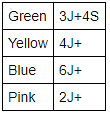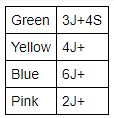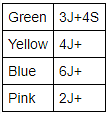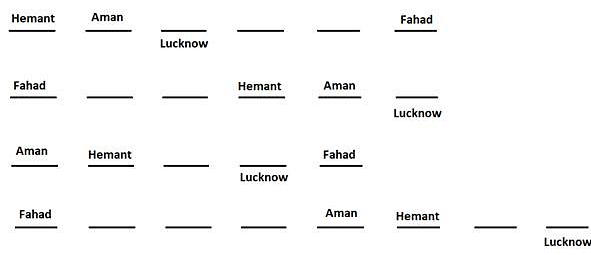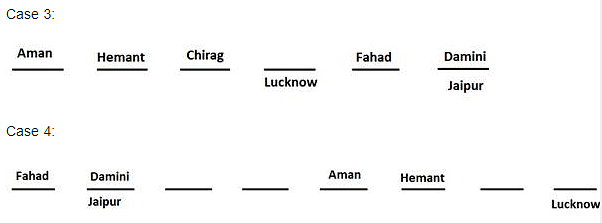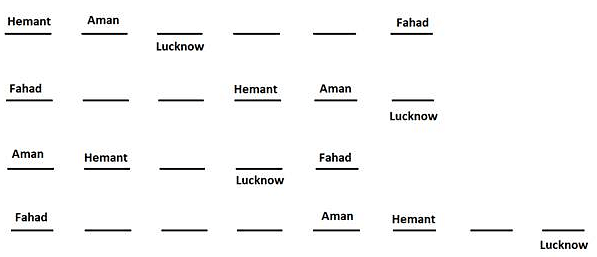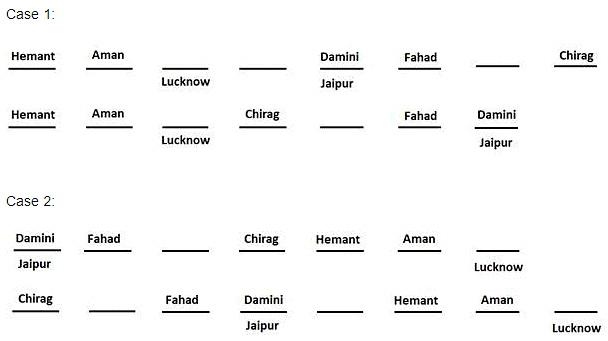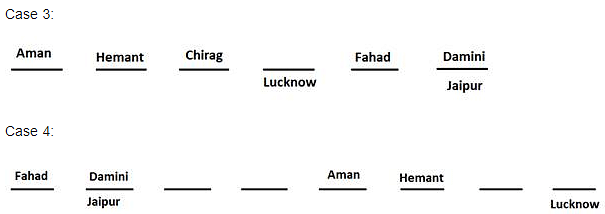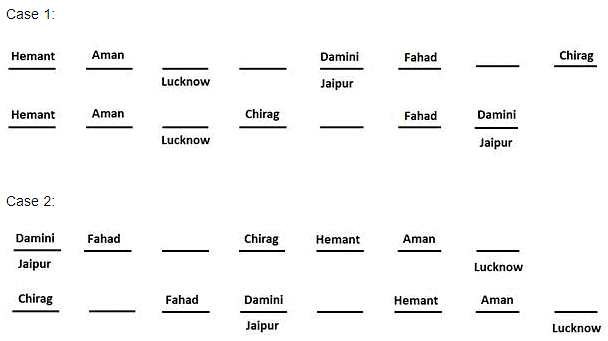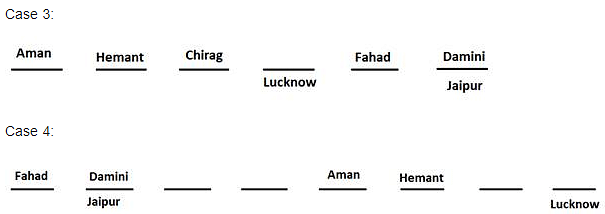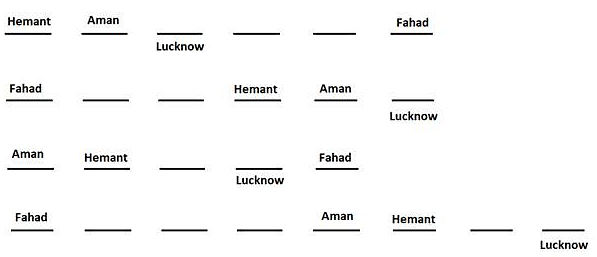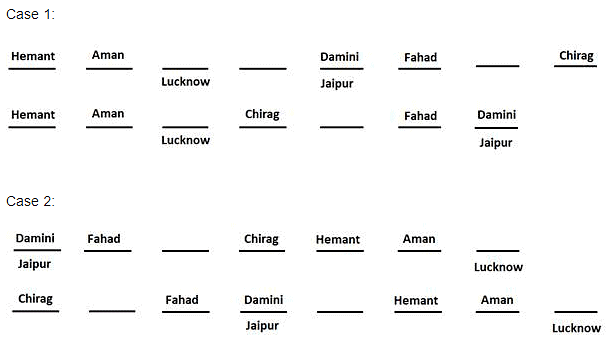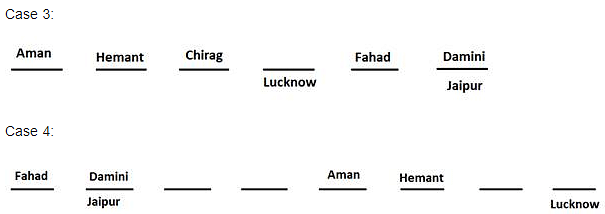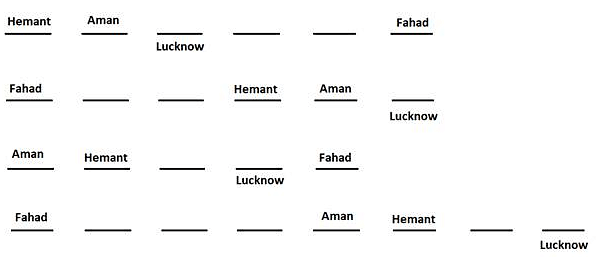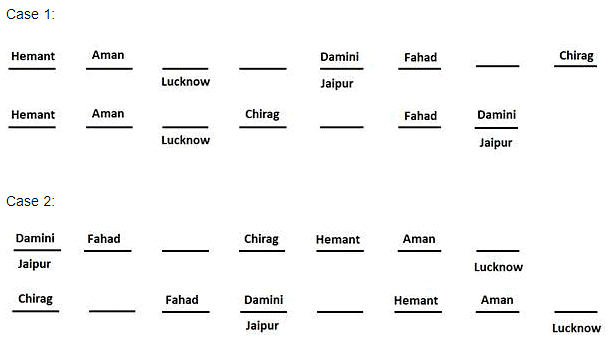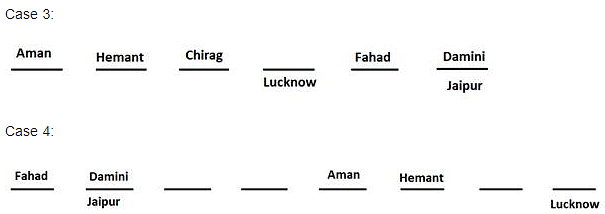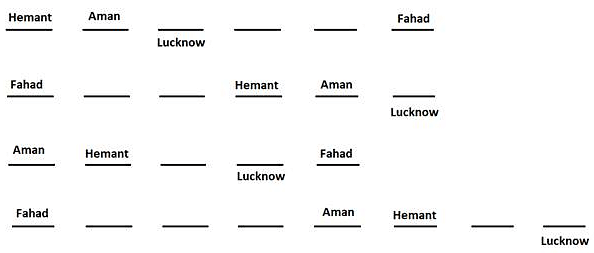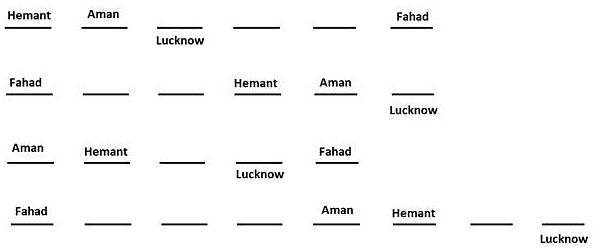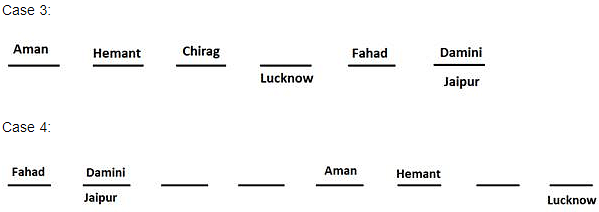MAH-CET MBA Mock Test- 13 - CAT MCQ
30 Questions MCQ Test - MAH-CET MBA Mock Test- 13
Directions. Study the following information carefully and answer the given questions:
The following is an illustration of an input and the rearrangement. (All the numbers are two digits numbers)
Input: 79 36 arrange words 25 83 border them
Step 1: arrange 79 words 25 83 border them 36
Step 2: arrange border 79 words 83 them 36 25
Step 3: arrange border them 79 words 36 25 83
Step 4: arrange border them words 36 25 83 79
Step 5: 07 06 04 05 09 07 11 16
Step 5 is the last step of the above input, as the desired arrangement is obtained.
Now study the following input as per the arrangement and answer the questions that follows:
Input: 81 return winners 74 64 western high 24 09 kindness
Which element is exactly between 'winners' and 'western' in step 3 of the given arrangement?
Directions. Study the following information carefully and answer the given questions:
The following is an illustration of an input and the rearrangement. (All the numbers are two digits numbers)
Input: 79 36 arrange words 25 83 border them
Step 1: arrange 79 words 25 83 border them 36
Step 2: arrange border 79 words 83 them 36 25
Step 3: arrange border them 79 words 36 25 83
Step 4: arrange border them words 36 25 83 79
Step 5: 07 06 04 05 09 07 11 16
Step 5 is the last step of the above input, as the desired arrangement is obtained.
Now study the following input as per the arrangement and answer the questions that follows:
Input: 81 return winners 74 64 western high 24 09 kindness
What is the position of '24' from the right end in the second step?
| 1 Crore+ students have signed up on EduRev. Have you? Download the App |
Directions. Study the following information carefully and answer the given questions:
The following is an illustration of an input and the rearrangement. (All the numbers are two digits numbers)
Input: 79 36 arrange words 25 83 border them
Step 1: arrange 79 words 25 83 border them 36
Step 2: arrange border 79 words 83 them 36 25
Step 3: arrange border them 79 words 36 25 83
Step 4: arrange border them words 36 25 83 79
Step 5: 07 06 04 05 09 07 11 16
Step 5 is the last step of the above input, as the desired arrangement is obtained.
Now study the following input as per the arrangement and answer the questions that follows:
Input: 81 return winners 74 64 western high 24 09 kindness
Which of the following will be the penultimate step of the given arrangement?
Directions. Study the following information carefully and answer the given questions:
The following is an illustration of an input and the rearrangement. (All the numbers are two digits numbers)
Input: 79 36 arrange words 25 83 border them
Step 1: arrange 79 words 25 83 border them 36
Step 2: arrange border 79 words 83 them 36 25
Step 3: arrange border them 79 words 36 25 83
Step 4: arrange border them words 36 25 83 79
Step 5: 07 06 04 05 09 07 11 16
Step 5 is the last step of the above input, as the desired arrangement is obtained.
Now study the following input as per the arrangement and answer the questions that follows:
Input: 81 return winners 74 64 western high 24 09 kindness
How many numbers will be greater than the number on the extreme right end of the last step after the rearrangement?
Directions. Study the following information carefully and answer the given questions:
The following is an illustration of an input and the rearrangement. (All the numbers are two digits numbers)
Input: 79 36 arrange words 25 83 border them
Step 1: arrange 79 words 25 83 border them 36
Step 2: arrange border 79 words 83 them 36 25
Step 3: arrange border them 79 words 36 25 83
Step 4: arrange border them words 36 25 83 79
Step 5: 07 06 04 05 09 07 11 16
Step 5 is the last step of the above input, as the desired arrangement is obtained.
Now study the following input as per the arrangement and answer the questions that follows:
Input: 81 return winners 74 64 western high 24 09 kindness
What will be the position of 'western' with respect to '81' in the step-4?
Directions. Study the following information carefully and answer the given questions:
The following is an illustration of an input and the rearrangement. (All the numbers are two digits numbers)
Input: 79 36 arrange words 25 83 border them
Step 1: arrange 79 words 25 83 border them 36
Step 2: arrange border 79 words 83 them 36 25
Step 3: arrange border them 79 words 36 25 83
Step 4: arrange border them words 36 25 83 79
Step 5: 07 06 04 05 09 07 11 16
Step 5 is the last step of the above input, as the desired arrangement is obtained.
Now study the following input as per the arrangement and answer the questions that follows:
Input: 81 return winners 74 64 western high 24 09 kindness
How many steps will be required to complete the given arrangement based on the given input?
Directions. Study the following information carefully and answer the given questions:
There are six persons A, B, C, D , E and F. C is the sister of F. B is the brother of E's husband. D is the father of A and grandfather of F. There are two fathers, three brothers and a mother in the group. Which of the following is a group of brothers ?
Directions : 6 chairs were kept in a row facing North. The chairs were of different colour white, red, yellow, green, blue and pink not necessarily in the same order. These chairs had different number of jackets and shirts stacked on them, number ranged between 1-6. Every chair had 1 garment of each kind. A jacket when folded and stacked occupied 11cm and a shirt occupied 6cm.
• Blue chair was 3rd to the left of the chair that had 5 jackets
• Number of jackets on the yellow chair was equal to the number of shirts on the green chair
• White chair's neighbouring chair had clothes stacked till a height of 41cm
• Pink chair was neighbouring the yellow chair and the chair that had 2 shirts
• Green chair had 7 garments in total stacked on it, where the number of shirts was more than the number of jackets.
• Number of jackets on blue chair was thrice the number of jackets as that on the pink chair
• Red chair was 3rd to the left of the chair that had 6 shirts
• Pink chair did not have the least number of shirts
• Green chair was to the immediate left of the chair that had 1 jacket
Which chair had the maximum number of jackets?
Directions : 6 chairs were kept in a row facing North. The chairs were of different colour white, red, yellow, green, blue and pink not necessarily in the same order. These chairs had different number of jackets and shirts stacked on them, number ranged between 1-6. Every chair had 1 garment of each kind. A jacket when folded and stacked occupied 11cm and a shirt occupied 6cm.
• Blue chair was 3rd to the left of the chair that had 5 jackets
• Number of jackets on the yellow chair was equal to the number of shirts on the green chair
• White chair's neighbouring chair had clothes stacked till a height of 41cm
• Pink chair was neighbouring the yellow chair and the chair that had 2 shirts
• Green chair had 7 garments in total stacked on it, where the number of shirts was more than the number of jackets.
• Number of jackets on blue chair was thrice the number of jackets as that on the pink chair
• Red chair was 3rd to the left of the chair that had 6 shirts
• Pink chair did not have the least number of shirts
•Green chair was to the immediate left of the chair that had 1 jacket
Which of the following chairs was stacked till the maximum height?
Directions : 6 chairs were kept in a row facing North. The chairs were of different colour white, red, yellow, green, blue and pink not necessarily in the same order. These chairs had different number of jackets and shirts stacked on them, number ranged between 1-6. Every chair had 1 garment of each kind. A jacket when folded and stacked occupied 11cm and a shirt occupied 6cm.
• Blue chair was 3rd to the left of the chair that had 5 jackets
• Number of jackets on the yellow chair was equal to the number of shirts on the green chair
• White chair's neighbouring chair had clothes stacked till a height of 41cm
• Pink chair was neighbouring the yellow chair and the chair that had 2 shirts
• Green chair had 7 garments in total stacked on it, where the number of shirts was more than the number of jackets.
• Number of jackets on blue chair was thrice the number of jackets as that on the pink chair
• Red chair was 3rd to the left of the chair that had 6 shirts
• Pink chair did not have the least number of shirts
•Green chair was to the immediate left of the chair that had 1 jacket
What was the difference between the number of shirts kept on the green chair and on the pink chair?
Directions: 6 chairs were kept in a row facing North. The chairs were of different colour white, red, yellow, green, blue and pink not necessarily in the same order. These chairs had different number of jackets and shirts stacked on them, number ranged between 1-6. Every chair had 1 garment of each kind. A jacket when folded and stacked occupied 11cm and a shirt occupied 6cm.
• Blue chair was 3rd to the left of the chair that had 5 jackets
• Number of jackets on the yellow chair was equal to the number of shirts on the green chair
• White chair's neighbouring chair had clothes stacked till a height of 41cm
• Pink chair was neighbouring the yellow chair and the chair that had 2 shirts
• Green chair had 7 garments in total stacked on it, where the number of shirts was more than the number of jackets.
• Number of jackets on blue chair was thrice the number of jackets as that on the pink chair
• Red chair was 3rd to the left of the chair that had 6 shirts
• Pink chair did not have the least number of shirts
•Green chair was to the immediate left of the chair that had 1 jacket
What was the position of the green chair with respect to the chair which had 4 jackets?
The question below consists of a question and two statements numbered I and II. You have to decide whether the data provided in the statements are sufficient to answer the question. Read both the statements and give the answer.
Point A is towards which direction from point B?
I. If a person walks 4 m towards the North from point A, he would reach point C, which is 8 m away from point B.
II. Point D is 2 m towards the East of point A and 4 m towards the West of point B.
Directions : Eight persons Aman, Bobby, Chirag, Damini, Eshan, Fahad, Gautam and Hemant were eight professionals working in the IT Industry. They met at an IT conclave where they were seated in a straight row facing the north. They worked in different cities Lucknow, Jaipur, Delhi, Mathura, Chennai, Kolkata, Mumbai and Hyderabad not necessarily in the same order.
• Hemant was 2nd to the left of the one working in Lucknow.
• Aman was neighbouring Hemant and was seated at a gap of 3 persons from Fahad.
• Fahad's neighbour was working in Jaipur.
• Eshan was working in Mumbai and was 3rd to the left of the one who was working in Mathura.
• The person working in Hyderabad was seated at either of the extreme ends.
• Person working in Kolkata was seated to the immediate right of Chirag.
• Gautam was to the immediate left of Bobby.
• Damini's neighbour worked in Delhi and Damini was working either in Kolkata or in Jaipur.
• Damini and Chirag were seated at a gap of 2 persons.
Who among the following was seated at the extreme right end of the row
Directions : Eight persons Aman, Bobby, Chirag, Damini, Eshan, Fahad, Gautam and Hemant were eight professionals working in the IT Industry. They met at an IT conclave where they were seated in a straight row facing the north. They worked in different cities Lucknow, Jaipur, Delhi, Mathura, Chennai, Kolkata, Mumbai and Hyderabad not necessarily in the same order.
• Hemant was 2nd to the left of the one working in Lucknow.
• Aman was neighbouring Hemant and was seated at a gap of 3 persons from Fahad.
• Fahad's neighbour was working in Jaipur.
• Eshan was working in Mumbai and was 3rd to the left of the one who was working in Mathura.
• The person working in Hyderabad was seated at either of the extreme ends.
• Person working in Kolkata was seated to the immediate right of Chirag.
• Gautam was to the immediate left of Bobby.
• Damini's neighbour worked in Delhi and Damini was working either in Kolkata or in Jaipur.
• Damini and Chirag were seated at a gap of 2 persons.
In which of the following cities was Aman working?
Directions : Eight persons Aman, Bobby, Chirag, Damini, Eshan, Fahad, Gautam and Hemant were eight professionals working in the IT Industry. They met at an IT conclave where they were seated in a straight row facing the north. They worked in different cities Lucknow, Jaipur, Delhi, Mathura, Chennai, Kolkata, Mumbai and Hyderabad not necessarily in the same order.
• Hemant was 2nd to the left of the one working in Lucknow.
• Aman was neighbouring Hemant and was seated at a gap of 3 persons from Fahad.
• Fahad's neighbour was working in Jaipur.
• Eshan was working in Mumbai and was 3rd to the left of the one who was working in Mathura.
• The person working in Hyderabad was seated at either of the extreme ends.
• Person working in Kolkata was seated to the immediate right of Chirag.
• Gautam was to the immediate left of Bobby.
• Damini's neighbour worked in Delhi and Damini was working either in Kolkata or in Jaipur.
• Damini and Chirag were seated at a gap of 2 persons.
Who was seated 3rd to the right of the person working in Kolkata?
Directions : Eight persons Aman, Bobby, Chirag, Damini, Eshan, Fahad, Gautam and Hemant were eight professionals working in the IT Industry. They met at an IT conclave where they were seated in a straight row facing the north. They worked in different cities Lucknow, Jaipur, Delhi, Mathura, Chennai, Kolkata, Mumbai and Hyderabad not necessarily in the same order.
• Hemant was 2nd to the left of the one working in Lucknow.
• Aman was neighbouring Hemant and was seated at a gap of 3 persons from Fahad.
• Fahad's neighbour was working in Jaipur.
• Eshan was working in Mumbai and was 3rd to the left of the one who was working in Mathura.
• The person working in Hyderabad was seated at either of the extreme ends.
• Person working in Kolkata was seated to the immediate right of Chirag.
• Gautam was to the immediate left of Bobby.
• Damini's neighbour worked in Delhi and Damini was working either in Kolkata or in Jaipur.
• Damini and Chirag were seated at a gap of 2 persons.
How many persons were seated between Gautam and Aman?
Directions : Eight persons Aman, Bobby, Chirag, Damini, Eshan, Fahad, Gautam and Hemant were eight professionals working in the IT Industry. They met at an IT conclave where they were seated in a straight row facing the north. They worked in different cities Lucknow, Jaipur, Delhi, Mathura, Chennai, Kolkata, Mumbai and Hyderabad not necessarily in the same order.
• Hemant was 2nd to the left of the one working in Lucknow.
• Aman was neighbouring Hemant and was seated at a gap of 3 persons from Fahad.
• Fahad's neighbour was working in Jaipur.
• Eshan was working in Mumbai and was 3rd to the left of the one who was working in Mathura.
• The person working in Hyderabad was seated at either of the extreme ends.
• Person working in Kolkata was seated to the immediate right of Chirag.
• Gautam was to the immediate left of Bobby.
• Damini's neighbour worked in Delhi and Damini was working either in Kolkata or in Jaipur.
• Damini and Chirag were seated at a gap of 2 persons.
In which of the following groups was the 1st person seated exactly in between (neighbouring) the 2nd and the 3rd person?
Directions : Eight persons Aman, Bobby, Chirag, Damini, Eshan, Fahad, Gautam and Hemant were eight professionals working in the IT Industry. They met at an IT conclave where they were seated in a straight row facing the north. They worked in different cities Lucknow, Jaipur, Delhi, Mathura, Chennai, Kolkata, Mumbai and Hyderabad not necessarily in the same order.
• Hemant was 2nd to the left of the one working in Lucknow.
• Aman was neighbouring Hemant and was seated at a gap of 3 persons from Fahad.
• Fahad's neighbour was working in Jaipur.
• Eshan was working in Mumbai and was 3rd to the left of the one who was working in Mathura.
• The person working in Hyderabad was seated at either of the extreme ends.
• Person working in Kolkata was seated to the immediate right of Chirag.
• Gautam was to the immediate left of Bobby.
• Damini's neighbour worked in Delhi and Damini was working either in Kolkata or in Jaipur.
• Damini and Chirag were seated at a gap of 2 persons.
In which of the following places was Fahad working?
Directions : A, B, C, D, E and F are members of a detective agency. To keep things secret, only certain detectives can contact other detectives. The only contacts allowed are:
A can contact both B and D.
E can be contacted by B, C and F.
D can contact C.
E can contact both B and D.
F can be contacted by C.
A detective can receive a message from any detective who can contact him and, in turn,
relay the message to any detective he can contact.
Which of the following detectives cannot be contacted by any other detective in the agency?
Directions : A, B, C, D, E and F are members of a detective agency. To keep things secret, only certain detectives can contact other detectives. The only contacts allowed are:
A can contact both B and D.
E can be contacted by B, C and F.
D can contact C.
E can contact both B and D.
F can be contacted by C.
A detective can receive a message from any detective who can contact him and, in turn,
relay the message to any detective he can contact.
D can get a message from which of the following detectives by using exactly one intermediate contact?
I. E
II. B
III. F
Directions : A, B, C, D, E and F are members of a detective agency. To keep things secret, only certain detectives can contact other detectives. The only contacts allowed are:
A can contact both B and D.
E can be contacted by B, C and F.
D can contact C.
E can contact both B and D.
F can be contacted by C.
A detective can receive a message from any detective who can contact him and, in turn,
relay the message to any detective he can contact.
How can E send a message to C?
Directions : A, B, C, D, E and F are members of a detective agency. To keep things secret, only certain detectives can contact other detectives. The only contacts allowed are:
A can contact both B and D.
E can be contacted by B, C and F.
D can contact C.
E can contact both B and D.
F can be contacted by C.
A detective can receive a message from any detective who can contact him and, in turn,
relay the message to any detective he can contact.
If, for security reasons, E cannot be contacted then which of the following messages can be sent either directly or with an intermediary?
Directions : A, B, C, D, E and F are members of a detective agency. To keep things secret, only certain detectives can contact other detectives. The only contacts allowed are:
A can contact both B and D.
E can be contacted by B, C and F.
D can contact C.
E can contact both B and D.
F can be contacted by C.
A detective can receive a message from any detective who can contact him and, in turn, relay the message to any detective he can contact.
If the following messages were sent using the smallest possible number of intermediaries, which message would require the greatest number of intermediaries?
Directions : A, B, C, D, E and F are members of a detective agency. To keep things secret, only certain detectives can contact other detectives. The only contacts allowed are:
A can contact both B and D.
E can be contacted by B, C and F.
D can contact C.
E can contact both B and D.
F can be contacted by C.
A detective can receive a message from any detective who can contact him and, in turn,
relay the message to any detective he can contact.
If for security reasons, D cannot be contacted, which of the following message cannot be sent, either directly or through an intermediary?
Should the use of performance enhancing drugs be permitted in professional sports?
I. No, because it would be unfair on athletes who do not use these drugs, and excel on their merit.
II. Yes, because adult athletes should have the freedom to take drugs that might have adverse impacts on health.
In the questions below, a short passage is given outlining a point. Read the passage, and answer the question that follow.
In 2015, a large-scale aluminium refinery was opened by company T on the border of the village X. After the yield of the farms in the neighbourhood where the refinery had opened declined, the landholders complained to the government that air pollution from the refinery was harming their crops, and that the factory should be shut down. On being enquired, the company spokesperson replied that the crops were affected due to fungal diseases, not due to air pollution caused by the refinery. Having employed scientists to study the issue in depth, the conclusion was reached that the crops had been damaged by fungal infections. Nevertheless, the government ordered that the refinery should be shut down.
All of the following would strengthen the government's decision except:
1. Air pollution from the refinery has altered the chemical balance such that harmful fungi are thriving.
2. The air pollution from the refinery was not damaging crops in nearby plantations, but was affecting the quality of life of the residents.
3. The refinery was violating the permissible limits of pollutants that it could discharge into the environment.
4. The fungi responsible for the damage to the crops was found in the locality even before the refinery opened.
5. The landowners were against the setting up of the refinery even before the yield declined.
Directions : Read the following information, and answer the questions that follow.
Salman: The high-speed rail (HSR) owes its genesis to the competition railways faced from fast-moving automobiles and airplanes. It is but natural for India to aspire to join the exclusive club of developed nations having a HSR network. After all, it has the dream of becoming the third largest economy in 25 years.
Jugal: The HSR project is a vanity project which has little or no justification on the grounds of economic viability or public service. Even the vanity angle, looking to position India among the ranks of developed countries, is a huge overreach. Only a handful of high-income countries with specific demographics have high-speed rail. It is a wasteful project which only serves to deliver an illusory feel-good perception among the wealthy.
Jugal's argument would be most strengthened by providing data on which of the following?
1. The possible alternatives to high-speed rail used by developed countries
2. How much this project would cost and how much revenue it would generate in India
3. The number of developed countries that have high-speed rail
4. The states this project would be implemented in
5. The revenue generated from the public transportation sector in India
Directions : Read the following information, and answer the questions that follow.
Salman: The high-speed rail (HSR) owes its genesis to the competition railways faced from fast-moving automobiles and airplanes. It is but natural for India to aspire to join the exclusive club of developed nations having a HSR network. After all, it has the dream of becoming the third largest economy in 25 years.
Jugal: The HSR project is a vanity project which has little or no justification on the grounds of economic viability or public service. Even the vanity angle, looking to position India among the ranks of developed countries, is a huge overreach. Only a handful of high-income countries with specific demographics have high-speed rail. It is a wasteful project which only serves to deliver an illusory feel-good perception among the wealthy.
Refer to the extract in the previous question. Salman apparently believes that:
1. The current transportation system of India is not enough for it to be considered a developed country.
2. Growth of the economy goes hand in hand with the development of high speed rail.
3. Indian aspirations to develop HSR trump the costs it will have to incur.
4. The HSR project, if implemented in India, will have both economic viability, and potential to do public service.
5. Only if India develops an HSR network, it will be counted as a developed country.
Directions: Read the following information carefully and answer the question given below-
The following table shows the numbers of students scoring different percentages from 6 engineering colleges and ratio of the number of boys to girls in the colleges. (Note: 40% to 50% means above 40% and up to 50%)
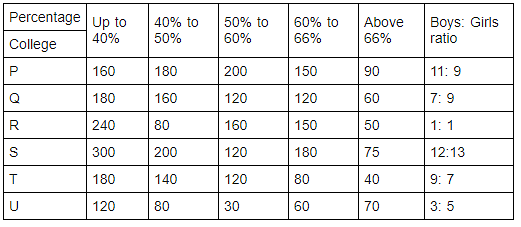
What is the ratio of total number of students scored above 50% from colleges P and Q together to the total number of students who scored up to 60% from colleges R and S together?
Match the statements from column 1 with column 2 and find which of the following pair of statements given in the options make contextually and grammatically correct sense.



